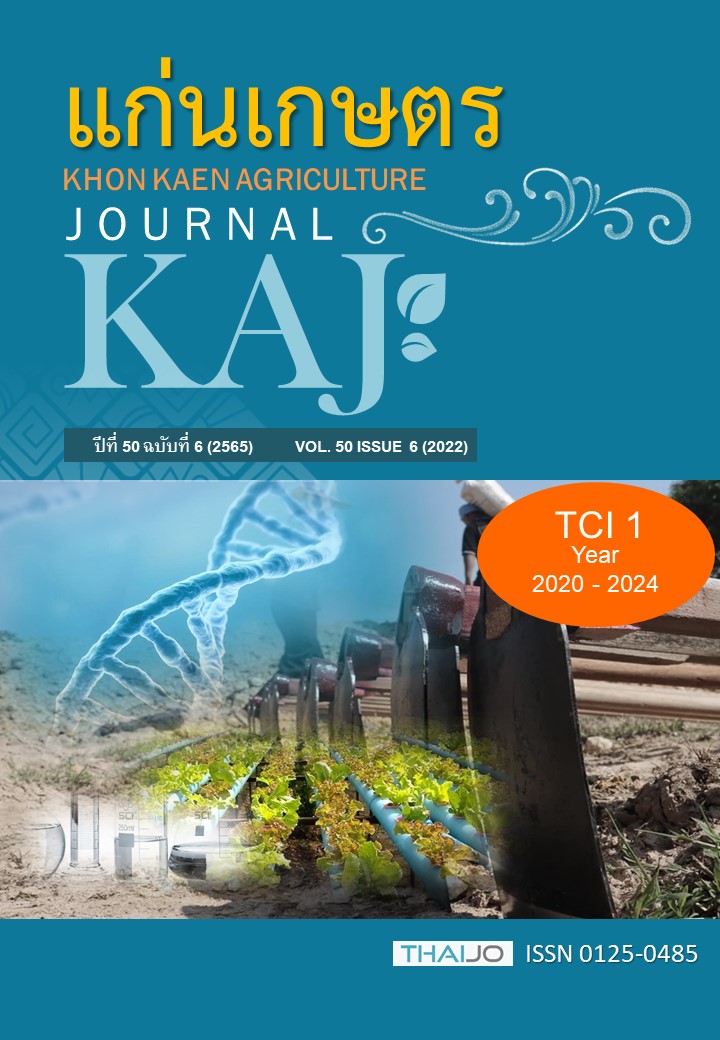ผลของการเสริมซีสทีอามีน ไฮโดรคลอไรด์ และกัวนิดิโนอะซิเตทในอาหารต่อสมรรถภาพ การเจริญเติบโตและคุณภาพซากของสุกรระยะขุน
Main Article Content
บทคัดย่อ
ซีสทีอามีน ไฮโดรคลอไรด์ และกัวนิดิโนอะซิเตท เป็นสารชีวภาพที่มีบทบาทตอบสนองทางสรีรวิทยาสนับสนุนการเจริญเติบโตของสัตว์ ในการศึกษาครั้งนี้จึงมีวัตถุประสงค์เพื่อศึกษาผลของการเสริมซีสทีอามีน ไฮโดรคลอไรด์ และกัวนิดิโนอะซิเตทต่อสมรรถภาพการเจริญเติบโตและลักษณะซากของสุกรระยะขุน โดยใช้สุกรจำนวน 162 ตัว (น้ำหนักตัว 61.91±4.88 กก.) แบ่งสุกรออกเป็น 3 กลุ่ม โดยจัดกลุ่มทดลองแบบบล็อกสมบูรณ์ (randomized complete block design: RCBD) สุกรแต่ละกลุ่มได้รับอาหารทดลอง ดังนี้ กลุ่มที่ 1 อาหารพื้นฐาน (กลุ่มควบคุม) กลุ่มที่ 2 อาหารที่มีการเสริมซีสทีอามีน ไฮโดรคลอไรด์ 700 ก./ตันอาหาร และกลุ่มที่ 3 อาหารที่มีการเสริมกัวนิดิโนอะซิเตท 1,000 ก./ตันอาหาร เป็นระยะเวลา 74 วัน จากการศึกษาพบว่าการเสริมซีสทีอามีน ไฮโดรคลอไรด์ และกัวนิดิโนอะซิเตท ส่งผลทำให้น้ำหนักสุดท้าย น้ำหนักตัวที่เพิ่มขึ้น และอัตราการเจริญเติบโตมีค่าเพิ่มขึ้น อย่างไรก็ตามอัตราการเปลี่ยนอาหารเป็นน้ำหนักตัวลดลง (P<0.05) เมื่อเปรียบเทียบกับสุกรที่ได้รับอาหารกลุ่มควบคุม นอกจากนี้การเสริมซีสทีอามีน ไฮโดรคลอไรด์ และกัวนิดิโนอะซิเตทส่งผลทำให้น้ำหนักมีชีวิต เปอร์เซ็นต์เนื้อสันนอก และสันในเพิ่มขึ้น (P<0.05) นอกจากนี้สุกรที่ได้รับอาหารเสริมซีสทีอามีน ไฮโดรคลอไรด์มีความหนาของไขมันสันหลังของสุกรลดลง (P<0.05) ในขณะที่เปอร์เซ็นต์เนื้อสันคอและเนื้อแดงเพิ่มขึ้น เมื่อเปรียบเทียบกับสุกรกลุ่มอื่น (P<0.05) สรุปได้ว่าการเสริมซีสทีอามีน ไฮโดรคลอไรด์ และ กัวนิดิโนอะซิเตทสามารถปรับปรุงสมรรถภาพการเจริญเติบโตและลักษณะของคุณภาพซาก โดยไม่ส่งผลต่อต้นทุนค่าอาหารต่อการเพิ่มน้ำหนักตัว 1 กก.ของสุกรระยะขุน
Article Details

This work is licensed under a Creative Commons Attribution-NonCommercial-NoDerivatives 4.0 International License.
References
จุฑารัตน์ เศรษฐกุล. 2556. วิธีการวัดคุณภาพซากสุกร. น.12. ใน: ประชุมวิชาการวิทยาศาสตร์และเทคโนโลยีเนื้อสัตว์ ครั้งที่ 4 เรื่องการเพิ่มผลผลิตและคุณภาพของเนื้อสุกร: เทคโนโลยีการตัดแต่ง 19 กรกฎาคม 2556. โรงแรมรามาการ์เดน, กรุงเทพฯ.
วรรณพร ทะพิงค์แก. 2560. อาหารและการให้อาหารสัตว์ (Feeds and Feeding). ศูนย์บริหารงานวิจัย คณะเกษตรศาสตร์ มหาวิทยาลัยเชียงใหม่, เชียงใหม่.
อุทัย คันโธ. 2559. อาหารสุกรและสัตว์ปีกเชิงประยุกต์. บริษัท บีพีเค พริ้นติ้ง จำกัด, กรุงเทพฯ.
AOAC. 1990. Official Methods of Analysis, 15th ed. Association of Official Analytical Chemists, Washington DC.
Balsom, P.D., K. Soderlund, B. Sjodin, and B. Ekblom. 1995. Skeletal muscle metabolism during short duration high-intensity exercise: influence of creatine supplementation. Acta Physiologica Scandinavica. 154: 303-310.
Canada Pork International. 2014. The official Canadian Pork Quality Standards (CPQS) for meat colour, fat colour and marbling (intramuscular fat). the Canadian Centre for Swine Improvement Agriculture and Agri-Food, Canada.
Casey, A., D. Constantin-Teodosiu, S. Howell, E. Hultman, and P.L. Greenhaff. 1996. Creatine ingestion favorably affects performance and muscle metabolism during maximal exercise in humans. American Journal of Physiology-Endocrinology and Metabolism. 271: E31-E37.
Coleman, M.E., L. Russell, and T.D. Etherton. 1994. Porcine somatotropin (pST) increases IGF-I mRNA abundance in liver and subcutaneous adipose tissue but not in skeletal muscle of growing pigs. Journal of Animal Science. 72: 918-924.
Dunshea, F.R. 2007. Porcine somatotropin and cysteamine hydrochloride improve growth performance and reduce back fat in finisher gilts. Australian Journal of Experimental Agriculture. 47: 796-800.
Farshidfar, F., M.A. Pinder, and S.B. Myrie. 2017. Creatine supplementation and skeletal muscle metabolism for building muscle mass-Review of the potential mechanisms of action. Current Protein and Peptide Science. 18: 1273-1287.
Hanbunchong, A., and A. Sinchermsiri. 1989. Feed analysis and evaluation. Kasetsart University, Bangkok (in Thai).
Jayaraman, B., L. Kinh, L.T.T. Huyen, D. Vinh, M.E. Carpena, M. Rademacher, and G. Channarayapatna. 2018. Supplementation of guanidinoacetic acid to pig diets: Effects on performance, carcass characteristics and meat quality. Journal of Animal Science. 96: 2332-2341.
Lemme, A., J. Ringel, A. Sterk, and J.F. Young. 2007. Supplemental guanidinoacetic acid affects energy metabolism of broilers. PP. 26-30. In: Proceedings of the 16th European Symposium on Poultry Nutrition. French Branch of WPSA, Strasbourg, France.
Liu, G., Z. Wang, D. Wu, A. Zhou, and G. Liu. 2009. Effects of dietary cysteamine supplementation on growth performance and whole-body protein turnover in finishing pigs. Livestock Science. 122: 86-89.
Liu, G., Y. Wei, Z. Wang, D. Wu, and A. Zhou. 2008. Effects of dietary supplementation with cysteamine on growth hormone receptor and insulin-like growth factor system in finishing pigs. Journal of Agricultural and Food Chemistry. 56: 5422-5427.
Liu, Y., J.L. Li, Y.J. Li, T. Gao, L. Zhang, F. Gao, and G.H. Zhou. 2015. Effects of dietary supplementation of guanidinoacetic acid and combination of guanidinoacetic acid and betaine on postmortem glycolysis and meat quality of finishing pigs. Animal Feed Science and Technology. 205: 82–89.
Lu, Y., T. Zou, Z. Wang, J. Yang, L. Li, X. Guo, Q. He, L. Chen, and J. You. 2020. Dietary guanidinoacetic acid improves the growth performance and skeletal muscle development of finishing pigs through changing myogenic gene expression and myofibre characteristics. Journal of Animal Physiology and Animal Nutrition. 104: 1875-1883.
Machlin, L.J. 1972. Effect of porcine growth hormone on growth and carcass composition of the pig. Journal of Animal Science. 35: 794-800.
Melmed, S., S. Yamashita, H. Yamasaki, J. Fagin, H. Namba, H. Yamamoto, M. Webe, S. Morita, J. Webster, and
D. Prager. 1996. IGF-I receptor signalling: lessons from the somatotroph. Recent Progress in Hormone Research. 51: 189-215.
Michiels, J., L. Maertens, J. Buyse, A. Lemme, M. Rademacher, N.A. Dierick, and S.d. Smet. 2012. Supplementation of guanidinoacetic acid to broiler diets: Effects on performance, carcass characteristics, meat quality and energy metabolism. Poultry Science. 91: 402-412.
NRC. 1998. Nutrient Requirements of Swine. Subcommittee on Swine Nutrition, Committee on Animal Nutrition, National Research Council ,Washington, D.C.
Sacheck, J.M., A. Ohtsuka, S.C. McLary, and A.L. Goldberg. 2004. IGF-I stimulates muscle growth by suppressing protein breakdown and expression of atrophy-related ubiquitin ligases, atrogin-1 and MuRF1. American Journal of Physiology-Endocrinology and Metabolism. 287: 591–601.
Steel, R.G.D., and J.H. Torrie. 1980. Principles and Procedures of Statistics: A Biometrical Approach.: 2nd ed. McGraw-Hill, New York.
Tao, W.J., L.J. Liu, H. Li, X. Pei, G. Wang, Z.P. Xiao, R. Yu, Z.F. Li, and M.Q. Wang. 2020. Effects of coated cysteamine on growth performance, carcass characteristics, meat quality and lipid metabolism in finishing pigs. Animal Feed Science and Technology. 263: 114480. DOI: 10.1016/j.anifeedsci.2020.114480.
Tsigos, C., and G.P. Chrousos. 2002. Hypothalamic–pituitary–adrenal axis, neuroendocrine factors and stress. Journal of Psychosomatic Research. 53: 865-871.
Wyss, M., and R. Kaddurah-Daouk. 2000. Creatine and creatinine metabolism. Physiological Reviews. 80: 1107-1213.
Zhou, P., L. Zhang, J. Li, Y. Luo, B. Zhang, S. Xing, Y. Zhu, H. Sun, F. Gao, and G. Zhou. 2015. Effects of dietary crude protein levels and cysteamine supplementation on protein synthetic and degradative signaling in skeletal muscle of finishing pigs. PLoS ONE. 10(9): e0139393. DOI: 10.1371/journal.pone.0139393.

